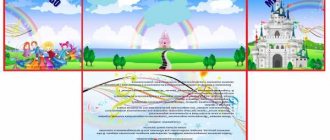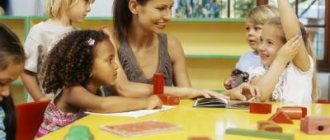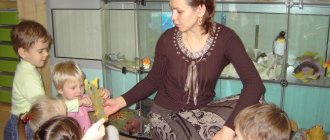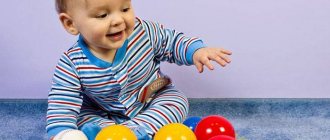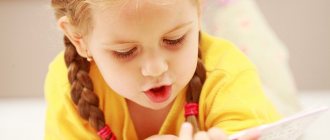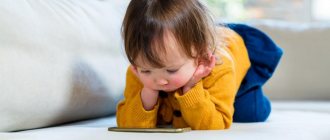“Development of speech in children of primary preschool age in play activities”
Author:
Timofeeva Irina Sergeevna,
teacher
MADO kindergarten No. 79 in Tyumen
The relevance of the study is determined by the unique role played by the native language in the formation of the personality of a preschool child. Language and speech have traditionally been considered in psychology, philosophy and pedagogy as a “node” in which various lines of mental development converge - thinking, imagination, memory, emotions. Being the most important means of human communication and knowledge of reality, language serves as the main channel for introducing the values of spiritual culture from generation to generation, as well as a necessary condition for education and training. Preschool age is a period of active acquisition by a child of spoken language, the formation and development of all aspects of speech. The work touches upon the problem of children's speech development in play activities, since in preschool age this type of activity is the leading one. The reason for the urgent need to develop children's speech is the need for a person to communicate with the people around him, and in order for speech to be intelligible, understandable and interesting to others, it is necessary to develop it, it is necessary to conduct a variety of games, to develop methods for conducting games so that children are interested in gaming activities.
Currently, there is a critical situation in the development of speech activity in young children, which is due to a number of negative factors affecting speech function: deterioration in the health of children; a significant narrowing of the volume of “live” communication between parents and children; global decline in the level of speech culture in society. Emotional coldness in the family adversely affects the child’s mental development and communication. The most important prerequisite for improving children's speech activity is the creation of an emotionally favorable situation that promotes the desire to actively participate in verbal communication. And it is play activity that helps create situations in which children’s speech develops.
I work with children of primary preschool age and observe children and their development. Play is the leading activity of a child. The game accompanies the child from birth, remains with him in childhood, adolescence, right up to the transition to adolescence. The game reflects the train of thoughts and feelings of children, leading them along the path of understanding reality.
Thus, I defined for myself the purpose and objectives of the work.
Target:
— speech development of preschool children in play activities. To achieve this goal, I set the following tasks in my work:
— formation of a dictionary; — development of sound culture of speech, coherent speech; - formation of the grammatical structure of speech; - development of speech as a means of communication.
I began my work on this topic by studying methodological literature and the best practices of my colleagues, which helped me build my own concept of speech support for young children through play activities. In my daily work with the children in my group, I definitely use games. The most important prerequisite for improving children's speech activity is the creation of an emotionally favorable situation that promotes the desire to actively participate in verbal communication. And it is play activity that helps create situations in which children’s speech develops. Of great importance for the development of speech is the living environment in which a child is raised, and the attitude of an adult towards him. In the development of speech, the leading role belongs to adults: the teacher in kindergarten, parents and loved ones in the family. The speech culture of adults, how they speak to the child, and how much attention they pay to verbal communication with him, largely determine the success of a preschooler in mastering the language.
Therefore, I consider it relevant to use various types of games for the development of speech in preschool children.
With the help of didactic games I activate children's vocabulary. Each didactic game has its own program content. In this regard, the program content of the game also includes a certain group of words that the child must master. Didactic games are educational games. They are created by adults for the purpose of raising and educating children. For children at play, educational value is realized through a game task, game actions, and rules. In the process of educational activities with children, play acquires special significance: it serves as a means for instilling in children new positive speech skills. So, playing didactic games with toys and objects with kids, such as: “The doll Masha woke up”, “Toy Store”, I help children consolidate their knowledge of the names of clothes, tableware, and activate their speech.
I use board and printed games in my work: “Paired Pictures”, “Loto”, etc. In such games I formulate speech, consolidate children’s knowledge about plants, animals and their babies, vegetables and fruits. With the accumulation of nouns, generalizing concepts (clothing, dishes, furniture) appear in children's dictionaries.
Manipulating with toys during the game, they indicate actions: walking, sleeping, eating, etc., i.e. using verbs. In the games: “More - Less”, “Wonderful Bag”, I teach children to see the features of objects and highlight characteristic features and qualities, reinforce children’s knowledge about color and size, and enrich their vocabulary with adjectives.
I regularly encourage children to create cut-out pictures and cubes. In this type of game, I solve a problem - I form in children the ability to think logically, and develop their ability to compose a whole object from individual parts. But before giving the task of putting together a picture from its parts, I let the children look at the whole picture. When working with children, I think the combination of visuals and words is effective. Bright objects and pictures make the baby want to look at them. Exploring the world around him, the child learns verbal designations of objects and phenomena of reality, their properties, connections and relationships. To expand, enrich and activate the vocabulary, I use didactic exercises: “Wonderful bag”, “Guess what it sounds like”. These exercises are varied and involve the use of words belonging to different parts of speech. I also enrich children’s vocabulary in didactic games: “Guess and name”, “Guess who came to us”, “Who is doing what”, “Name the animals and tell me who screams what”.
Creating an emotionally favorable situation contributes to the desire to actively participate in verbal communication. And it is theatrical play that helps create situations in which even the most uncommunicative and constrained children enter into dialogue and open up. Theater for a child is always a holiday, a bright, unforgettable experience. After all, theatrical activities are the most common type of children's creativity. Why theatrical activities? Theatrical activities are one of the most effective ways to influence children, in which the principle of learning is most fully and clearly demonstrated: learn by playing. Theatrical play has a great influence on the child’s speech development: it stimulates active speech by expanding the vocabulary and improves the articulatory apparatus. The child learns the richness of his native language and its means of expression. Using expressive means and intonations that correspond to the character of the characters and their actions, he tries to speak clearly so that everyone can understand him. In theatrical play, didactic, emotionally rich speech is formed. Children better assimilate the content of the work, the logic and sequence of events, their development and causality. Theatrical games promote the assimilation of elements of verbal communication (facial expressions, gestures, posture, intonation, voice modulation).
In my work on the development of children’s speech in theatrical activities, I use the following methods and techniques: gaming: - use of elements of outdoor play - surprise moments - imitation movements with elements of onomatopoeia - playing out the text - verbal: - repetition of speech material - questions - use of texts with repeating elements - reading works with onomatopoeia - finishing words, phrases - praise - visual: - using illustrations for texts - using toys, puppet theater characters.
To ensure that children’s interest in theatrical games does not fade away, I adhere to certain requirements:
- content and variety of topics - constant inclusion of theatrical games in all forms of the pedagogical process - maximum activity of children at the stages of preparation and conduct of games - cooperation of children with each other and adults at all stages of theatrical activities.
Of a special nature is the game that children create themselves, reproducing in it what is close and interesting to them (the actions of people with household objects, labor processes, people’s attitude towards each other, their recreation, entertainment, etc.). In such games, the theme, content, and sequence of displayed events are not predetermined by adults; they are based on the life experience of children; the rules seem to be hidden in the content of the events displayed. Such games are called creative, plot-based role-playing games. The game develops the ability to replace objects and actions, which ensures the gradual development of elements of more abstract thinking and speech. Favorable prerequisites for the development of abstract thinking and speech are already created in the play of young children in connection with the generalization and complication of play action. The first joint games instill in children a sense of collectivism and friendship. Kids learn to communicate, make requests and proposals to their comrades. With the timely formation of a plot game, children begin to play together, sometimes three, and enter into role-playing interaction. In games such as “Hairdresser”, “At the Doctor’s Appointment”, I introduce children to the names of professions, teach them to take on a role, perform the appropriate actions (cutting, combing their hair, treating, giving injections, etc.).
Initially, the children imitate what I showed them; over time, they begin to independently organize the game, enter into dialogue, and transfer actions from one object to another. During games, I encourage children to name the objects they use and pronounce the actions they perform. There are a lot of games, they can be very different, but active games occupy a special place among them. The comprehensive influence of outdoor games on a child’s development can hardly be overestimated. With skillful guidance from adults, these games can work wonders. Games are often accompanied by poems and songs. The poetic text determines the course of the game, regulates the motor activity of children and their behavior. Kids listen to the words of the text and focus on the content. Poetic syllables set the rhythm of movement. Movements with speech accompaniment cultivate a sense of beauty, the ability to listen to every word of the teacher, and activate attention. When the game is repeated, the kids remember the words and begin to sing along. Movements with pronouncing individual words and onomatopoeia are one of the effective methods for developing motor skills and stimulating the development of auditory perception. When conducting outdoor games with text, I use appropriate attributes (pictures with game characters, I encourage them to repeat the text. I make sure to involve even shy children in the game, who reveal their capabilities in the game, they develop speech, kids learn to communicate with others. In outdoor games for After the child accepts the plot, I characterize the image being depicted and the toys must speak, thus creating a true play situation.
I made a card index of outdoor games with texts.
A developing subject-spatial environment ensures the creative and speech development of children based on play activities. It not only provides play activities, but is also designed to help establish effective communication between children and the teacher and with each other.
There is no doubt that the development of speech in children of any age is one of the priority tasks in training and education. The child’s speech develops constantly in everyday life, in play, in communication and accompanies him in any activity, but in order for learning to take place easily and freely, without strict rules and intrusiveness, the use of games in the pedagogical process will help. In my work, I analyzed the literature on this issue, revealed the role of the influence of play activities on the speech development of young children, studied the mechanism of managing the game and the methodology for conducting direct educational activities, and used various forms of work with parents.
Gaming activities serve to consolidate the knowledge acquired in the classroom and activate the vocabulary. It is a natural state, a need of the child’s body, a means of communication and joint activities of children. Gaming activity creates that positive emotional background against which all mental processes occur most actively. It reveals the individual abilities and personal qualities of the child, allows us to determine the level of his knowledge and ideas, which is necessary for the further effective work of the teacher with each child.
Based on the above, we can conclude that the work done on the development of speech in young children was successful thanks to correctly selected material and systematic, targeted work. The pupils' active vocabulary was replenished, the grammatical structure of their speech improved, and their thinking processes developed. Children began to express their emotions through speech, withdrawn children became more sociable with peers and teachers, and began to better understand other children in the group.
In the future I plan to continue working in this direction. I consider it advisable to replenish the methodological box with new games, manuals, and to specify the material in order to obtain improved results in my work. I plan to refine the material for working with parents (develop consultations, visualization for the group reception).
Literature used, Internet sources:
Photos from the teacher’s archive
“Certificate of publication in the media” Series A No. 0005885
The certificate is attached to the letter.
We invite teachers of preschool education in the Tyumen region, Yamal-Nenets Autonomous Okrug and Khanty-Mansi Autonomous Okrug-Yugra to publish their teaching materials: - Pedagogical experience, original programs, teaching aids, presentations for classes, electronic games; — Personally developed notes and scenarios of educational activities, projects, master classes (including videos), forms of work with families and teachers.
Why is it profitable to publish with us?
1. 1. “Kindergartens of the Tyumen Region” is an officially registered specialized media outlet at the federal level. 2. The activities of the editorial office are supported by the Department of Education and Science of the Tyumen Region 3. We issue a “Certificate of Publication” in the media. 4. The document has a unique number, is entered in the register, has the original seal of the editorial office of the online publication and signature. 5. “Certificate of publication” in the media is sent to the author in both paper and electronic versions. In detail In detail >>> Sample “Certificate of publication of author’s methodological material in the media”.pdf
Share
Characteristics of speech of a younger preschooler
In the third year of life, children can observe an important turning point in their relationships with the outside world and people. This is due to the growth of their capabilities and awareness of themselves as an independent being.
The child tries to act like an adult, but he needs the assessment that elders give to his activities and actions. Children in early preschool age listen carefully to explanations, and at the same time they themselves begin to turn to adults more often with various questions. The youngest preschooler receives new impressions, which is a necessary condition for his mental development.
Note 1
At the age of 3, the child begins to intensively use verbs and pronouns. The researchers explained this fact by the increase in activity and expansion of the child’s contacts with others.
Finished works on a similar topic
- Course work Features of speech in children of primary preschool age 400 rub.
- Abstract Features of speech in children of primary preschool age 220 rub.
- Test work Features of speech in children of primary preschool age 230 rub.
Receive completed work or specialist advice on your educational project Find out the cost
Adjectives that begin to appear in children's speech are able to characterize mainly the size of an object (large or small), as well as its color. Along with this, the child already notices and reflects in his speech that the object belongs to a certain person (mother, father, aunt). He already characterizes the state he is experiencing (wet, hungry), conveys his aesthetic experiences (clean, beautiful).
The presence of adverbs and adjectives in children's speech indicates that these parts of speech are just beginning to form. Children master the simplest and most undifferentiated spatial, temporal and other relationships that can be expressed using words (for example, there, here, then, this, that, etc.).
In the process of mastering more precise, differentiated relationships and qualities, children experience difficulties and need the help and support of educators. If we talk about the intensive quantitative and qualitative growth of vocabulary characteristic of children of this age, we can point to three levels of word acquisition: names of objects, actions, qualities, relationships:
Too lazy to read?
Ask a question to the experts and get an answer within 15 minutes!
Ask a Question
- Understanding the word, but the inability to use it in speech;
- Recognizing and naming an object (action, quality, etc.) only in familiar combinations and conditions (scissors for cutting nails);
- Understanding and correct use of words-names in any understandable connections and relationships.
Didactic games in speech development
To increase the efficiency of using the game, it is necessary to use didactic games, systematize them and arrange them in the form of a card index.
The peculiarity of didactic games is that their educational content includes rules and actions, which helps children learn the content. After all, the motive for completing tasks arises precisely in the process of gaming activity. Children play, but at the same time they acquire the necessary information and use previously acquired knowledge.
This allows us to make didactic games an important type of organization of teaching preschoolers their native language.
The method of forming the speech of younger preschoolers for the optimal solution of problems of a speech nature, to maintain interest and to create an atmosphere of spontaneity, as well as for emotionality, involves the use of the following methods and techniques:
- active use of communicative as well as gaming motivation;
- creating problem situations, alternating direct teaching methods with game ones, as well as introducing indirect influence methods - game rules, didactic materials, dramatization techniques;
- the use of children's personal and choral responses, as well as motor and verbal ones;
- the use of a variety of demonstration materials;
- the use of tasks in which preschoolers change their posture and move (the game specificity of these tasks forces children to accept imaginary situations and teaches them play actions).
Speech of children 3-4 years old
In 3-4 year olds, speech develops quite quickly. Usually, by the age of three, a child practically masters his native language. The vocabulary of three-year-olds is growing every day: up to 100 new words come into use per month. A four-year-old child already has a vocabulary of about 2 thousand words. In children of this age, the sound design of words becomes better, phrases sound more developed. It should be noted that not all children develop in the same way. Some children have some delay in speech: they speak unclearly, words and individual sounds are pronounced incorrectly. Children often shorten words, skip and rearrange sounds and syllables. The speech of three-year-old children is of the same type and simple. However, even at such an early age, children show interest in words.
Development of speech at an early age
Let's discuss the dynamics of studying different speech aspects.
Sound pronunciation. Children's hearing becomes quite developed already in the early stages of development. At one and a half years old, children correctly reproduce syllables in words consisting of two syllables. And at two years old, in 75 percent of cases they can correctly name all three syllables in three-syllable words.
Preschoolers perceive the rhythm in a word, its intonation coloring, and stress quite easily. At the end of the second year of schooling, children have mastered entire groups of spoken sounds.
At two years old, when a child hears a sample, he tries to correct his own pronunciation. At this time, not having the ability to correctly pronounce any sounds, children pick up their erroneous pronunciation from others.
The specificity of pronunciation in children at three and four years old is approximately the same. According to A.N. Gvozdev, at this time the child learns sounds, and they can both pronounce them correctly and make omissions, replace and liken sounds, and soften them.
It is known that whistling, sonorous and hissing sounds are difficult to pronounce. Children begin to master them at just over two years of age. In the fourth year of life, their pronunciation of words begins to improve significantly if children repeat the correct pronunciation pattern after adults.
At the same time, the pronunciation of sounds during this period is still unstable. Preschoolers are rarely able to pronounce them correctly when the model is not spoken to them. It often happens that when they pronounce a new sound clearly, they begin to make mistakes when pronouncing those sounds that they previously learned.
This affects the choice of those linguistic means with the help of which the child produces speech. The most important task for a child at this age is to master non-situational communication both when talking with peers and with adults. Children feel this and try to master precise linguistic means, develop literacy in their pronunciation, free speech, and construct coherent contextual statements.
Younger preschoolers easily violate the literacy of their pronunciation when teaching work is weakened, when groups are overloaded, when there is a noisy environment, when they get sick. Children who speak clearly, when they find themselves in the company of children and peers with pronunciation defects, often begin to distort the words themselves.
Defects in pronunciation up to five years of age are usually acceptable, due to the fact that the speech apparatus has not completed its development, and the functions of breathing and the speech apparatus continue to form.
At three years old, speech becomes a tool of communication between peers. To study how younger preschoolers react to strangers, they observe whether children try to establish contacts, whether they wait, and whether they try to respond to communication.
If unfamiliar adults do not address children and express their affection towards them only with a smile and facial expressions, then only 2 percent of children try to get into contact with them. True, when adults actively turn to children, already every eighth child responds.
Of course, children experience shyness. But most importantly, they do not yet have experience interacting with different people. They have poorly developed motives for communication and tools for carrying out such activities.
Younger preschoolers have monotonous motives for communication, their linguistic expressions are quite simple.
